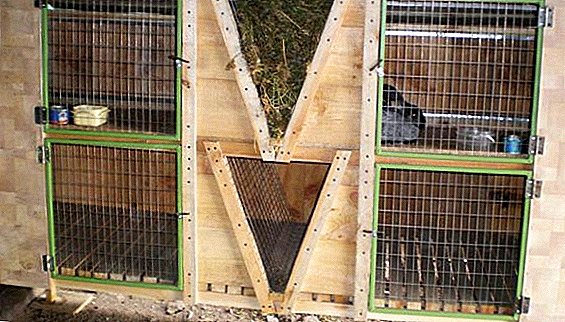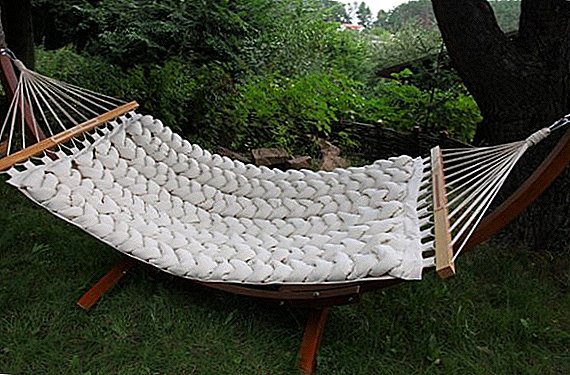 Surely almost every one of us rested in a cozy hammock in the hot summer time - this device is ubiquitous in gardens and at summer cottages. Today in stores there are many varieties of this detail of the dacha interior, but not always ready-made solutions for arranging a hammock make it possible to extract the necessary comfort from it to the maximum. In this case, the majority resorts to self-fabricating the device. In our article we decided to deal in detail with the main stages of creating a high-quality hammock, as well as the main features of this process.
Surely almost every one of us rested in a cozy hammock in the hot summer time - this device is ubiquitous in gardens and at summer cottages. Today in stores there are many varieties of this detail of the dacha interior, but not always ready-made solutions for arranging a hammock make it possible to extract the necessary comfort from it to the maximum. In this case, the majority resorts to self-fabricating the device. In our article we decided to deal in detail with the main stages of creating a high-quality hammock, as well as the main features of this process.
What is a hammock
Hammock - one of the varieties of outdoor garden furniture, used for sleeping or long rest. 
This part of the garden interior is actively used by all outdoor enthusiasts around the world, as it provides not only the necessary comfort for recuperation, but also allows you to relax in the open air.
The device is a regular rectangle of fabric or large woven mesh, which for two opposite ends is suspended above the surface of the earth. Often, two oppositely directed tree trunks act as a support, but artificially created structures are also used.
Did you know? The hammock was invented by the Mayan tribes in Central America more than 2 thousand years ago.
This design makes it possible to have a calming and lulling effect, as a result of which a normalization of the emotional state is observed. In addition, the hammock does not have monolithic and heavy structures, so it can be easily installed in almost any place. 
All this contributed to the emergence of many varieties of this garden furniture, several of which have been used even in living interiors.
What types are
As mentioned above, today there are many different types of hammocks, among which are both light removable structures and stationary prefabricated models. Each of them has its own characteristics of use and structure, so choosing the best option for yourself is not so easy.
You will also be interested to learn how to make a rocking chair with your own hands, a sofa from pallets, a garden swing, a garden table made of wood.
That is why before you get such furniture, you must be sure to get acquainted with the main features of each of the varieties.
Hammock
The most common and cheap way to equip comfort at their summer cottage is the classic suspended structure. 
It is fully capable of providing the necessary comfort, regardless of the conditions and place of arrangement.
The only thing that needs to be foreseen is that they are two supports directed against each other.
The following types of hammocks are known today:
- wicker - its basis is a large mesh, made of dense twine. This design has a lot of advantages, the main of which is the highest comfort and ease of repair, as the damaged grid can be repaired in just a few minutes;

- Caribbean - This hammocks, which are made of thick wear-resistant fabric. The main distinctive feature of such a device are bright and variegated shades of fabrics;

- white - is a conventional hammock made of artificial or natural fabric. Often, he settles in the middle of the room or on the terrace. Its main distinguishing feature is the snow-white shade of the fabric, which perfectly harmonizes with any interiors;

- retro - a usual fabric design, is made of materials of white or cream tones. Exquisite retro-style provides lace or fringe, which are decorated with such products to the maximum.

Did you know? The first mention of the hammock in modern history is found in the book "Chronicles of Peru" by the Spanish geographer and historian Ciez de Leon, dating from 1553.
Frame hammock
Frame hammock is a classic suspended structure of fabric or woven mesh, which is attached to a special artificial frame. Such a device has become a solution for many, since it is often not so easy to find a suitable place for a hammock between two branches of trees. 
Additionally, the frame can be equipped with a light umbrella that protects the person from the sun or small atmospheric precipitation.
Frame hammocks are of two types:
- prefab - it is easily constructed structures that are temporary. They are built on demand and as needed, and quickly understood. This is great to avoid cluttering the garden in case of limited space;

- stationary - complex monolithic structures to maintain a hammock. They are more resilient than prefabricated models, but not rarely are extremely cumbersome. That is why such devices are often not transportable, therefore they are built once, after which they serve for many years in the same place.

Hammock chair
The hammock chair can be called one of the most modern alternatives to the conventional hinged structure. One of the main features of such devices is the special position and angle of inclination: they allow you to rest comfortably not only lying, but also sitting and half-sitting.
Such designs are best suited for work, relax and socializing, as well as festive events. In addition, a hammock chair also differs in the way of its attachment, its design often provides for one, central, point of contact with the support. 
There are the following types of hammock:
- classic chair - is a semi-sitting construction, fixed to one, perpendicular to the support point (ceiling, beam or horizontal branch);

- armchair mounted on the rack - a design that is attached to a special vertical rod with a stand. This technical solution makes it possible to equip a hammock in almost any conditions, since the design can essentially support itself;

- armchair for two - a chair with an increased volume, it allows you to simultaneously hold from 1 to 3 people, weighing up to 200 kg. Such designs can be made both in a classical form, and with an additional fixing rack;

- child seats - small hammocks that can withstand a load of up to 35-40 kg. They are used in children's rooms or serve as an additional detail of the interior. They can be made both in a classical form, and with a special fastening support.

Hammock swing
Many do not include a hammock swing to a separate group of garden furniture, since they can be made in almost any form. But still they can be called a separate group of devices.
Often, the swing of such a plan is equipped in a classic form or in the form of a chair. A distinctive feature of such a hammock are two points of support at a short distance, which creates a primitive pendulum mechanism. 
Hammock swings are of two types:
- stationary - the swing is mounted to a fixed support (horizontal branch of a tree, a beam, etc.);

- traveling - swing is attached to a special bar with a stand. This decision makes it possible to move the structure around the site, and in the cold season to clean the inside of the room.

What is better to make a hammock
Today, for the production of the main part of the hammock uses a lot of materials, among them artificial and natural.
For the arrangement of the dacha you will also be interested to learn how to make a pond with your own hands, a gazebo of pallets, a fireplace, a summer shower, a swimming pool, concrete walkways, a waterfall, a fountain, rock arias, a dry stream.
But not every one of them will be suitable in a particular case, so before visiting the nearest hardware store, you need to weigh the pros and cons of each of them.

The most popular materials are:
- grid - is a uniformly intertwined rope ropes, fastened on both sides with the help of small wooden holders. Often, the material for the mesh is natural twine or thick ropes made of artificial materials with a diameter of at least 0.5 cm. Preferred is natural twine, since this material is able to more firmly bond with each other, which gives the mesh additional rigidity and strength. The mesh is durable, easy to clean, and the ability to repair damaged cells. But it also has drawbacks - it often rubs open areas of the body, therefore, it is possible to rest on it for a long time only with an additional soft bedding;
- cotton - One of the most common materials for the manufacture of hammocks. It has high strength and lightness, is pleasant to the touch, and also perfectly breathable and responds well to washing. However, cotton fiber does not differ in durability, therefore, after only 2-3 seasons, the base will require a complete replacement;
- silk - is almost perfect fabric. This material has the necessary mechanical strength, vapor permeability and wear resistance. Rest on silk fabric always brings only pleasant sensations and emotions. This fabric is perfectly washable and dries quickly. The only disadvantage of silk is its high cost;
- sackcloth - thick natural fabric made from thick yarn. Sacking is often made from hemp or sesame fiber, kenaf fibers, jute, etc. This fabric has high strength, vapor permeability and low price. However, it is not very pleasant to rest on the burlap without additional bedding, as it is caustic and unpleasant to the touch;
- synthetic fabric (polyester) is one of the most versatile options, synthetics is highly durable, but it remains light. That is why this material is especially popular with avid tourists, for whom the extra 0.5 kg in a backpack becomes a problem. But synthetic fabric, like any artificial fiber, is afraid of fire, so even the slightest spark will make a hole in it. In addition, this fabric does not allow the body to breathe, which creates considerable discomfort;
- tarpaulin - dense waterproof and fire-resistant semi-synthetic fabric. The basis of the tarpaulin is hemp, flax or sesame fiber, treated with all sorts of protective impregnations. The tarpaulin is characterized by high wear resistance and fire resistance, but it does not have vapor permeability, and is also quite weighty.
Did you know? Artificial fabric was first presented to the world in Paris, in 1889 at the "World Exhibition". Its inventor was the French chemist Count Louis-Marie Ileire Bernigo de Chardonnay.
How to make a hammock
In order to create a hammock with your own hands, there is no need for specific, narrowly focused knowledge and materials - often almost everyone in the garden house has everything you need. However, this process still has its own subtleties and nuances, on which the further success of installation depends.
How to make a hammock for 1 minute: video
So, after you have decided on the type of material for the hammock and its structural features, you can proceed to installation.
This will require the following:
- basis material 3x1.5 m (mesh, tarpaulin, cotton, polyester, etc.);
- wooden slats 50x50 cm and a length of 1.5 m;
- tight linen cord or string not less than 10 m long;
- rope length 10 m;
- 2 rings for fastening with a diameter of 10 cm;
- 2 carbines;
- thick needle with thick thread;
- scissors;
- drill and a set of drills for wood.
Important! When mounting the structure, it should be noted that the distance between the supports on each side should be 15-20 cm longer than the total length of the hammock, otherwise the structure will not have the necessary stability and comfort.
The main stages of installation:
- Cut the canvas according to the required dimensions and create an additional frame for it. To do this, along its side (longer) edges, you need to sew a rope into the material, the ends of which should be pulled out on both sides, parallel to each other. The final result on the canvas should be 4 tails of rope, which will play the role of fasteners in the future.
- Drill several through holes on the wooden slats along the entire length at a distance of 5-10 cm from each other.
- Pull the rope through the holes in the wooden slats, then fix them to the canvas with several knots. Excess rope ends should be cut.
- Cut from the cord the same strips about 40 cm long by the number of free holes on both wooden slats.
- Secure the strips of cord with one end to the wooden rail, and the other to the metal ring on each side.
- Wind the remains of the cord tight around the supports and create small loops on both edges, they will serve as a fixation point for the whole structure. The optimal height of the loops should not be lower than 1.5 m above ground level.
- Secure the hinges and rings to each other on both sides with carabiners. The design is ready for operation, at the end of the season it can be easily dismantled.

Rules of operation and installation of a hammock
Home hammock, like any part of the interior, has its own rules of safe operation. If they are not observed, outdoor recreation can cause serious injuries and bruises.
So, the rules for safe operation of a hammock are as follows:
- the maximum load of the average structure should not exceed 160 kg;
- in single-seated models it is forbidden to relax together;
- if the device is fixed at a height of more than 60 cm, it is imperative to provide a soft mat under it to absorb shock during a possible fall;
- fasteners and other construction details should not have sharp corners or cutting edges;
- during rest it is strongly not recommended to jump up or swing too actively;
- it is necessary to go to a hammock gradually and carefully, without sudden movements.
Important! If you have problems with the vestibular apparatus, it is not recommended to rest in a hammock, as this can cause discomfort.Hammock installation

Hammock Care
In most cases, the hammock does not cause problems with the care, but with the active use of the device in its area it is important to remember the following:
- hammock requires mandatory cleaning from all sorts of pollutants, so it must be periodically removed and cleaned;
- prolonged contact with rainwater is harmful to the device, so it must be dismantled during rain;
- direct sunlight and prolonged freezing adversely affect the durability of the whole structure, so the hammock must be carefully protected from these environmental factors;
- all fasteners and other construction details must be checked 2-3 times per season for any damage;
- if necessary, worn structural elements must be replaced with new ones.

A hammock is one of the main decorations of the garden plot, which not only brings a bright highlight to the garden interior, but also makes it possible to relax in the fresh air with comfort.
Today, there are many varieties of this device, but for more than a decade the simplest suspension structure has remained the most popular, which can be created without much difficulty even with one's own hands.
However, in order to rest in a hammock to remain comfortable, you must take care of general measures for safe operation of the device.












